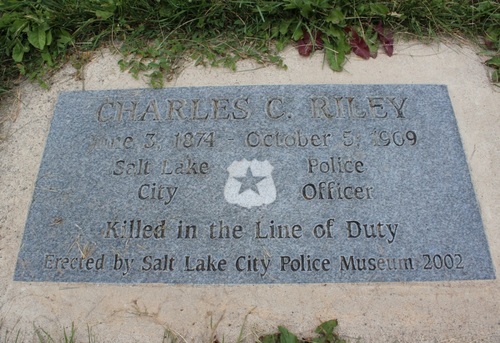This is an archived article that was published on sltrib.com in 2013, and information in the article may be outdated. It is provided only for personal research purposes and may not be reprinted.
Charles C. Riley paid the ultimate price to protect Salt Lake City, but the hero's face remains a mystery.
On Oct. 5, 1909, a Tuesday, Riley had just caught two bank robbers and was minutes away from locking them up when he was killed.
According to the Salt Lake City Police Department, two suspects had knocked over a bank at 100 S. 200 East. They were getting away with the cash, too — until they ran into Riley at 200 S. State St. The quick-acting, 34-year-old reserve officer arrested them and took it upon himself to escort the duo to jail.
They did not have far to walk. Back then, the jail was near 100. State Street, behind what is now the Federal Building.
"One block, not a big deal," said Lt. Mike Ross, a historian within the department.
Riley was marching the pair north on State Street toward their cells and was almost there — when one of them pulled out a pistol. The man shot the officer twice in full view of a large crowd of patrons at Orpheum Theater.
As Riley died, the duo fled.
Investigators caught the shooter and the accomplice a week later in Ogden. The shooter was convicted of first-degree felony murder and sentenced to life in prison. The man was later pardoned and paroled in 1920; Ross has not been able to find out why.
Riley, meanwhile was buried in Salt Lake City Cemetery in an unmarked grave. He left behind a wife and a young daughter, and was the fifth Salt Lake City officer to ever be killed in the line of duty.
As a reserve officer, Riley's neighbors in the Avenues had elected him to act as their local patrolman; he would have been trained by the police, but his wages came from a collective neighborhood pot, Ross explained.
Even though he was a reserve officer, Riley made a name for himself with his keen knowledge of the criminal activity occurring on Salt Lake City's streets. He had put it to use and helped bust a large burglary ring that plagued the downtown area, Ross said.
Riley finally received a headstone in 2002. But while the world can visit Lot 11 in the southwest section of the cemetery and see his name engraved, it still doesn't know his face.
There are no known photos of the fallen officer. In 2009, the Salt Lake City Police Department reached out to the public for any images of Riley that might be out there. As of today, the department has yet to receive one.
Riley is only one of two fallen Salt Lake City officers who the department has never been able to track down a picture of — the other is the first of their cops to ever die in the line of duty, William Cooke. This blog will tell the story of his death, and a mail carrier's eventual retribution against the killer, on Oct. 13, the 155-year anniversary.
If you come across a photo of either Riley or Cooke, contact the police department at 801-799-3100.
— Michael McFall



